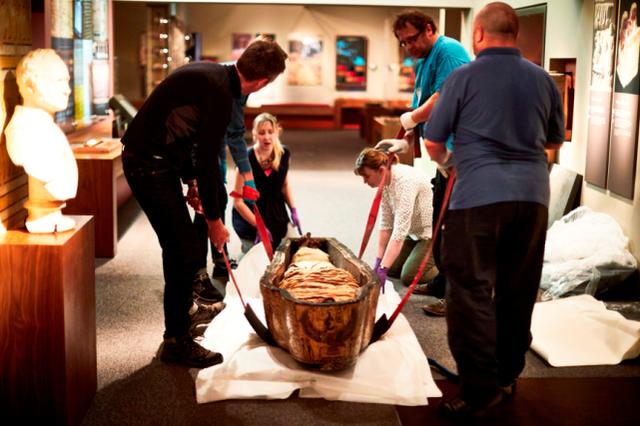科学家让三千多年前的木乃伊说话(双语科技惊)

Scientists have recreated the voice of an ancient, 3,000-year-old Egyptian mummy using 3D printing, medical scanners and an electronic larynx, a new study suggests.
一项新的研究表明,科学家利用3D打印技术、医用扫描仪和电子喉头,重现了一具3 000年前的古埃及木乃伊的声音。(可点击文末视频收听)
They were able to reproduce a single vowel sound, which sounds like something between the vowels in the words "bed" and "bad."
他们能够还原一个元音,听起来像是介于单词"bed"和"bad"之间的一个元音。
The tone is unlikely to be an exact replication of the speech of Egyptian priest Nesyamun, whose mummified body the researchers worked with, because the tongue has lost much of its bulk over 3,000 years.
研究人员的研究对象是埃及祭司内西亚蒙的遗骸,所重现的声调不太可能同内西亚蒙完全一样,因为在3 000多年的岁月里,他的大部分舌头都已经萎缩了。

"We have made a faithful sound for his tract in its current position, but we would not expect an exact speech match given his tongue state," said co-author David M. Howard of London's Royal Holloway College.
伦敦皇家霍洛威学院的合著者戴维·M.霍华德说:"根据他目前声道的状态,我们已经对他的声音作了忠实的还原,但由于他的舌头保存状况并不好,所以我们无法做到完全还原。"
Nesyamun lived during the politically volatile reign of pharaoh Ramses XI (c.1099–1069 B.C.), working as a scribe and priest at the state temple of Karnak in Thebes, which is modern Luxor.
内西亚蒙生活在拉美西斯十一世(约公元前1099年至公元前1069年)的政治动荡时期,在底比斯的卡纳克神庙(即现在的卢克索)担任抄写员和祭司。
His voice was an essential part of his ritual duties, which involved spoken as well as sung elements.
他的声音是他的仪式职责中必不可少的部分,包括布道和歌唱。

The precise dimensions of an individual's vocal tract makes each of our voices unique, so for the research to work, the soft tissue of Nesyamun's vocal tract had to be essentially intact, according to a statement from the University of York in the United Kingdom.
根据英国约克大学的一份声明,每个人声道的不同尺寸造就了我们独特的声音,因此这项研究要成功,内西亚蒙的声道软组织必须是基本完好无损的。
Researchers used a non-destructive CT scan to confirm that a significant part of the structure of the larynx and throat of Nesyamun remained intact as a result of the mummification process. This allowed the authors to measure the vocal tract shape from CT images.
研究人员通过非破坏性的CT扫描确认,得益于木乃伊化处理,内西亚蒙的咽喉部的一个重要结构仍然完好无损。这使得作者可以通过CT影像来测量其声道的形状。
Based on these measurements, the authors created a 3D-printed vocal tract for Nesyamun and used it with an artificial larynx commonly used in speech synthesis.
基于这些测量结果,作者为内西亚蒙打造了一个3D版的声道,并将其与语音合成中常用的人工喉头一起使用。

Co-author John Schofield, an archaeologist at the University of York, said the technique could be used to help people interpret historical heritage.
合著者约翰·斯科菲尔德是约克大学的考古学家,他说这项技术可以用来帮助人们理解历史遗产。
"When visitors encounter the past, it is usually a visual encounter," Schofield said. "With this voice we can change that and make the encounter more multidimensional."
"当游客邂逅过去时,通常是视觉上的邂逅," 斯科菲尔德说,"有了这个声音,我们就可以改变这种现状,使邂逅更加多元化。"
According to the study, the research "has produced the unique opportunity to hear the vocal tract output of someone long dead by virtue of their soft tissue preservation and new developments in technology, digital scanning and 3D printing."
根据这项研究,"通过保存死者的软组织,以及数字扫描和3D打印技术的新发展,就有望听到很久以前的死者的声音。"
The research was published in the British journal Scientific Reports.
该研究发表于英国杂志《科学报告》。

请戳下面的小视频感受一下来自3 000年前的声音吧,反正小编在午夜整理译文时,听到那一声鸡皮疙瘩都起来了……
本文英文选自usatoday,已选入《快捷英语 活页英语时文阅读理解 中考19》,参考译文由"快捷英语"提供。转载需注明出处。
,免责声明:本文仅代表文章作者的个人观点,与本站无关。其原创性、真实性以及文中陈述文字和内容未经本站证实,对本文以及其中全部或者部分内容文字的真实性、完整性和原创性本站不作任何保证或承诺,请读者仅作参考,并自行核实相关内容。文章投诉邮箱:anhduc.ph@yahoo.com






